Devin Allen got his first camera in 2013 — a Canon that his grandmother had purchased for him on credit from Best Buy. The self-taught photographer had begun exploring the form a year before, taking pictures of the poetry scene in his native Baltimore with a camera on loan from a friend.
That spawned an interest in the history of photography, particularly the contributions of Black photographers, that led Allen to study the work of the late Gordon Parks, who said "I chose my camera as a weapon against all the things I dislike about America — poverty, racism, discrimination."
Photography proved to be life-changing for Allen, who had felt powerless growing up in Baltimore and seeing his community struggle with many of the same socio-economic injustices that Parks had turned his camera on in the middle of the 20th century. As a young man, Allen saw how educational inequality, gentrification, violence, drugs, poverty and police brutality hurt his neighbors. He also lost several close friends to murder.
"I lived in this kind of false world where, like, 'this is it — I can't change anything.' ... But, when I started to unpack those things, I became an artist, and the art form gave me my voice. I started understanding that I do have a platform to make change," Allen said.

In 2014, Allen photographed his first protest, which had been sparked by the police killing of 18-year-old Michael Brown in Ferguson, Mo. A year later, in 2015, mass protests engulfed Allen's hometown following the death of 25-year-old Freddie Gray in Baltimore police custody. A lifelong resident, Allen was on the scene. His images of the protests that followed, which he first posted to his Instagram page, circulated across the country. One made it onto the cover of Time magazine.
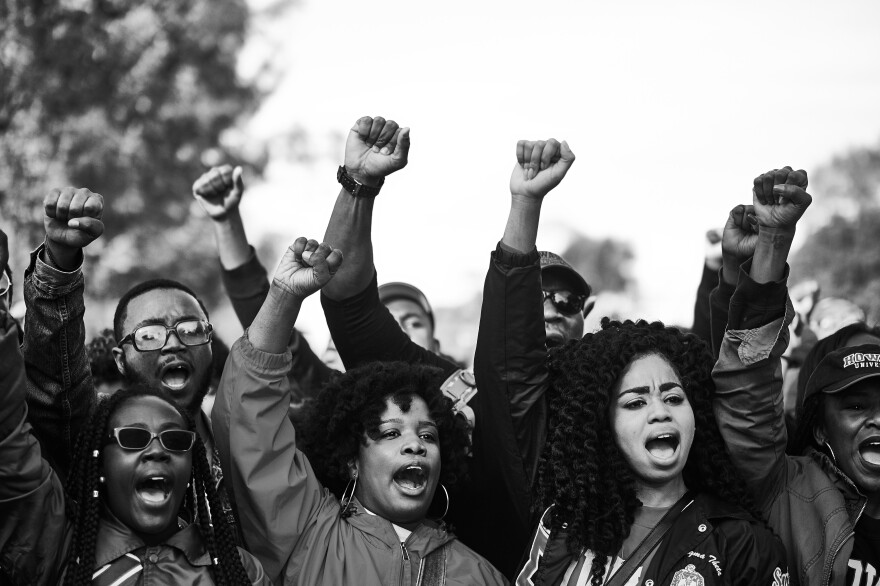
"That's when I finally understood that this camera is a weapon," Allen said. "I understood when Gordon was saying that that was the weapon that he turned to. And then, in turn, it became something — a weapon — for myself," he said, adding that he felt a deep sense of responsibility to document the movements unfolding around him.
Allen's photobook, "No Justice, No Peace: From the Civil Rights Movement to Black Lives Matter," which was released in October, is the culmination of his yearslong commitment to documenting protests against police brutality.
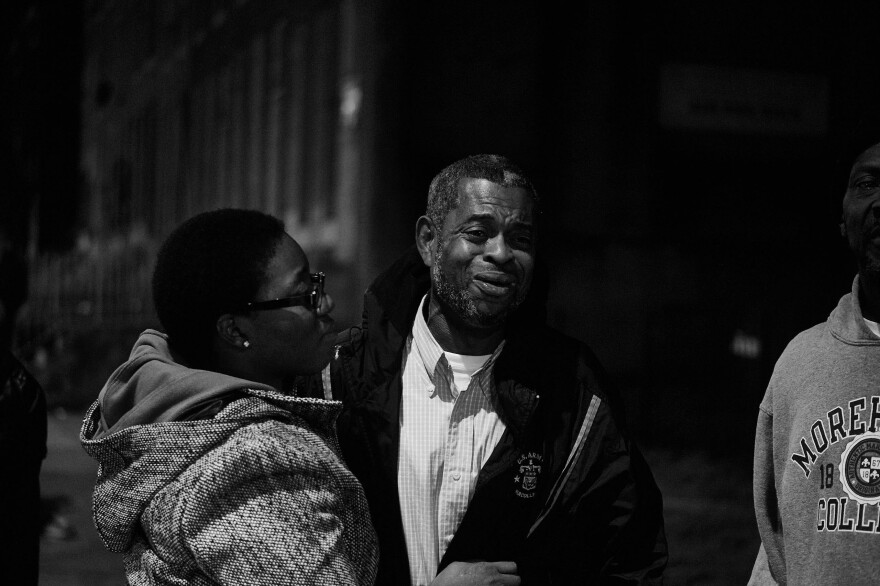
The opening pages set black-and-white images of Allen's photography capturing present-day protests alongside several made by Parks. In one of Parks' images, taken in Harlem in 1963, a hand holds the front page of a newspaper while a white woman brushes past the frame, her eyes averted from the headline, "Seven Unarmed Negroes Shot in Cold Blood by Los Angeles Police."
A few pages later, in a frame by Allen from 2020, protesters march through downtown Baltimore holding hand-painted signs that bear Eric Garner, Elijah McClain and George Floyd's last words — "I Can't Breathe" — and "How Many More?"
These juxtapositions, presented without captions and taken more than 50 years apart, allude to the decadeslong struggle that Black people in America have waged to be seen, heard and treated with dignity. They confront the viewer with the grim reality of how little has changed since the civil rights movement laid the groundwork for challenging police brutality.

But the pairings also ask what has changed and, more importantly, how we might continue to ride the momentum of the racial justice protests that have gripped the nation in recent years to create a more just, equitable and free world.
"No Justice, No Peace" aims, in part, to also answer these questions. The book features more than 100 protest photographs made by Allen between 2014 and 2022 and almost entirely in Baltimore alongside texts by emerging and established writers spanning the fields of activism, poetry, photography, law, academia and more, including Jamel Shabazz, Clint Smith, Jacqueline Woodson, DeRay Mckesson, Emmanuel Acho and Keeanga-Yamahtta Taylor.
The texts and images gesture at the motivations and grievances behind the scenes, on the sidelines and in the aftermath of protests.
Poet Wallace Lane reflects on racial health disparities, which became pronounced during the COVID-19 pandemic — "The same government who lynched us / It's no coincidence. / Pumped us and destroyed us with poison and carcinogens" — while formerly incarcerated entrepreneur Chris Wilson scrutinizes the school-to-prison pipeline: "At a time when the average American teenager was gearing up to make the most important decisions of their life, writing college essays and deciding on career paths, my whole life had been mapped out for me along the corridors of prison."
The queer Black poet W.J. Lofton calls for solidarity with queer and trans Black people and Black women while Kondwani Fidel meditates on the virality of Black death. Journalist Lawrence Burney corrects the incomplete record of Floyd's life by honoring his talent and love of music as a rapper in Houston's underground music scene — where he performed under the moniker "Big Floyd" — and D. Watkins dwells in the intoxicating feeling of coming together in protest, writing: "The adrenaline, the energy, the unity, the feeling you get when you inject fear into the oppressive system that crushes you every day, the same way it crushed your mom and crushed your grandma and great-grandma too — I enjoyed that feeling for the first time in 2015. And let me tell you, it's like a drug."

Many of the writers are from or live in Baltimore.
Together, the images and texts test the limits of justice — how we conceive of it, how we deploy it and how we might achieve it.
"I believe that Black people in America must control our narrative. We must document the times we live in — through protest, photography and words, like those of the talented writers throughout this book," Allen writes in his introductory essay.
'I had to continue this work'
Allen was born in West Baltimore in 1988 and raised by his mother, Gail Allen, whose writing also appears in the collection.
Frustrated by the indignities he witnessed his community grappling with, Allen decided to follow in Parks' footsteps and photograph the grief and resistance of those around him.
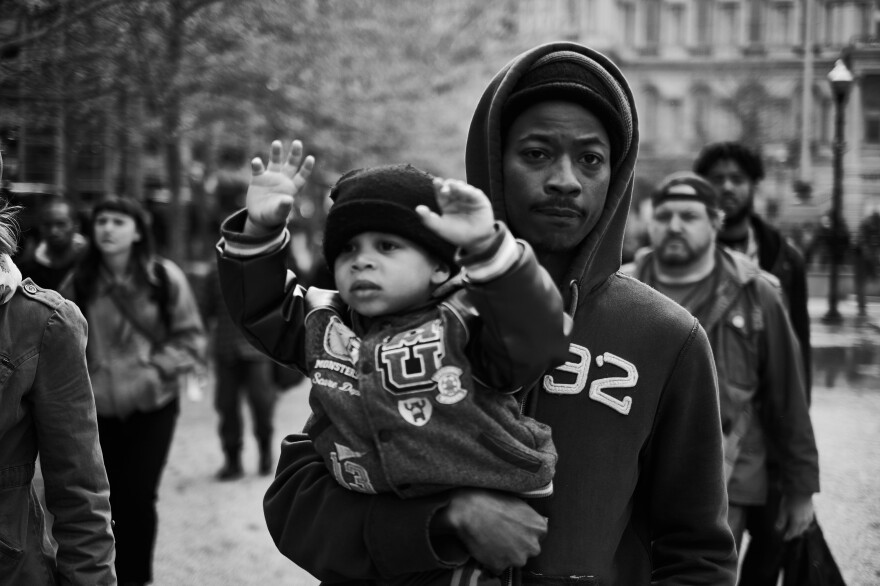
"I had to continue this work to let you know the times that we're in ... that people are being activated and inspired and have to do the same work that we've been doing for so long," Allen said.
His photographs counter the harmful stereotypes that have long dominated media depictions of Black people, from the myth of the "missing Black father" and the broken family to the depiction of protesters and victims of police brutality as "thugs."
Images of Black families standing together and bonding through activism figure prominently in "No Justice, No Peace," as do pictures of women at the forefront of protests in a society that still largely refuses to embrace them as leaders. In one photo, we see a man holding a child, the toddler's raised hands evoking the protest chant "Hands up, don't shoot." In another, we see a crying man being comforted by a woman at his side during a protest organized by the sister of Tyrone West, a 44-year-old man who died during an encounter with Baltimore police officers in 2013.
"A lot of the photo choices was to go against something," Allen said. "I love seeing families. ... I was raised by my mom and my grandmother, you know, and one of my favorite things to capture is the grace of a Black woman and all that power on the front lines," he said. "When you see it, it's like a sort of energy that you feel, [that] recharges you."
While photographing protests, Allen said he isn't just drawn to scenes of chaos. What sustains him, he said, are the moments of tenderness between people.

"Capturing those intimate moments when I see my people embracing each other, hugging and giving comfort — those are the moments, those intimate moments, that really inspire me, that really makes me feel it's going to be okay," Allen said.
'A full-circle story where everybody was seen'
Allen said he hopes his book helps bridge divisions, pushes back on stereotypes and shows people as they are while acknowledging the many different paths toward justice and freedom.
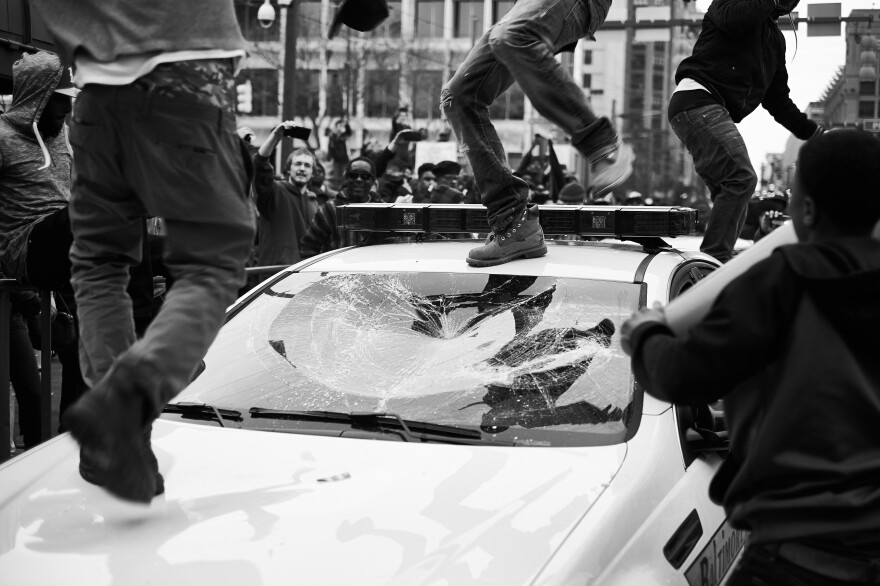
"I wanted to make sure it was a full-circle story where everybody was seen," he said, referring also to those who are doubly marginalized in American society and even within their own Black communities, particularly queer, transgender and gender non-conforming people.
The book includes photographs from the 2020 and 2021 Black Trans Lives Matter marches in Baltimore. The images were inspired, in part, by Allen's growth and journey to unpack his own discomfort with the LGBTQ community and the pressures of hypermasculinity that he had internalized and wrestled with as a Black man growing up in Baltimore.
"It's a part of you because you are around it every single day," he said. But years of being on the frontlines of protests and meeting people through his work have changed the way he looks at the world, Allen said, and he hopes to use his photography to address and heal wounds within the Black community, particularly those felt by its LGBTQ members.

"I was real adamant about shooting, you know, the trans march in Baltimore, because they show up for everyone," Allen said. "Their peers — Black men, some Black women — don't show up for them when they're protesting."
That's also reflected in protest signs, observed Allen, who is fascinated with the evolution of placards and what they reveal about a movement's inclusivity or lack thereof.
"You have to create signage to speak for yourself," he said, noting how LGBTQ people must carve out space for themselves at protests when others don't always make room for them.
"I thought we were all here to, you know, get to one thing ... to be free, so everybody can live free, to feel safe," Allen said, reflecting on these contradictions.
"It's really a simple concept if you can just accept everyone for who they are."
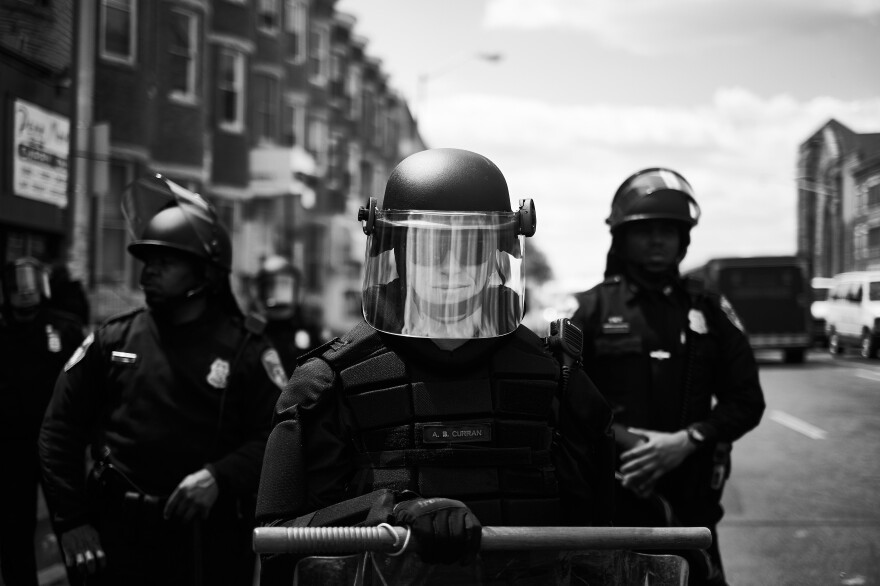
While "No Justice, No Peace" aims to take readers and viewers on an emotionally charged journey, Allen said it was important that the book also highlight the importance of self-care and rest, both on the streets and in daily life. Too often, he said, people involved in justice movements — including himself — feel pressure to show up and fight day in and day out because they fear that taking a break will halt progress. But in the process, they frequently let their own needs and their right to live joyful lives fall to the wayside.
"The book is meant to be heavy. I want to make you cry, I want to make you sad. But I do want you to see the joy. I do want you to recuperate," Allen said, drawing on the message of Tiffany Loftin, a former student organizer, at the end of the book.
"There should never be a Black person in this country who feels guilty for taking care of themselves or for enjoying their life," Loftin writes, adding, "Strength is both resisting injustice and indulging in the magic of the world."
Devin Allen is a Baltimore-based photographer. He is the founder of Through Their Eyes, a Baltimore-based youth photography education program, and his photographs have been included in collections at the National Museum of African American History and Culture and the Reginald F. Lewis Museum and the Studio Museum in Harlem. You can find more of his work on Instagram, at @bydvnlln.
Copyright 2023 NPR. To see more, visit https://www.npr.org.



